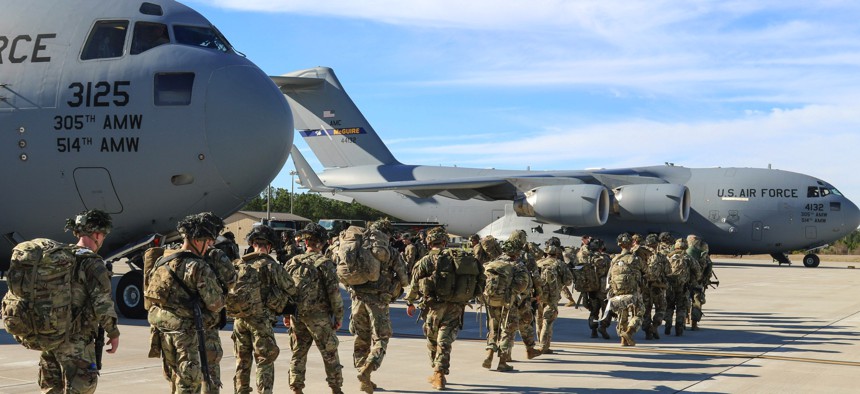
Army paratroopers assigned to the 2nd Battalion, 504th Parachute Infantry Regiment deploy from Pope Army Airfield, N.C., Jan. 1, 2020. Army Capt. Robyn J. Haake
Don’t Use the Iran Crisis As An Excuse To Boost Pentagon Spending
Use it to reconsider the American approach to national security.
From the Pentagon to Wall Street, the crisis between the United States and Iran is already – predictably – being cited as a rationale for increasing the Pentagon budget. Issue No. 1 should be doing everything in our power to head off another Mideast war. But along the way we should also make sure that the current situation is not exploited to underwrite an across-the-board increase in tax dollars for a department that is already substantially overfunded.
With thousands of additional troops headed to the Middle East and the president tweeting threats about the possibility of striking dozens of targets in Iran, the conventional wisdom is that the Pentagon’s current budget of $738 billion – which already far exceeds (in real terms) defense spending at the heights of the Korean or Vietnam wars – will have to go up.
One common assertion is that at current funding levels, it will be impossible to bolster the U.S. military presence in the Middle East in advance of a possible war with Iran while simultaneously preparing for a conflict with Russia or China. This line of reasoning is based on the Pentagon’s deeply flawed National Defense Strategy and its focus on great power rivalry. If one accepts the Pentagon’s premise – that war and preparation for war should be the central focus of America’s national security strategy – then no amount of spending is too much.
But if we should have learned anything in this century, it’s that doubling down on military solutions to complex security problems can be disastrously counterproductive. According to the Costs of War Project at Brown University, the United States has spent or obligated $6.4 trillion on its post-9/11 wars. More than 800,000 people have died on all sides of these wars, including well over 300,000 civilians. Thousands of U.S. troops have died and hundreds of thousands of veterans suffer from traumatic brain injuries or post-traumatic stress syndrome. The destabilizing effects of the U.S. intervention in Iraq helped set the stage for the creation of ISIS, while simultaneously supporting a sectarian post-Saddam regime that opened the door to greater Iranian influence in Iraq. In Afghanistan, the Taliban is stronger than ever after 18 years of war, a war that was sold to the American public by systematically misleading them about the prospects for success.
Will the wars in Iraq and Afghanistan be followed by yet another trillion-dollar war in the Middle East, this time with Iran? Before taking that immensely consequential step, it’s worth remembering how we got here.
The current crisis with Iran is largely of the Trump administration’s own making. It began when the administration walked away from the multilateral Iran nuclear deal, formally known as 2015’s Joint Comprehensive Plan of Action. The deal, which was working as planned to curb Iran’s nuclear weapons ambitions, was the result of years of tough, painstaking diplomacy involving not only the United States and its European allies, but Russia and China as well. The Iran deal could have served as a gateway to discussions of other pressing regional security issues. It was also a model of how multilateral diplomacy might be applied to other pressing regional and global issues. But instead of building on the Iran deal, the Trump administration trashed it in favor of the “maximum pressure” strategy of economic warfare and military threats that has brought us to the brink of a major conflict. Now that the Trump administration has taken it upon itself to kill the second-most-powerful person in the Iranian government with no clear evidence that he posed an imminent threat to U.S. citizens, the momentum towards war has accelerated dramatically. It’s time for Congress and the public to pull the Trump administration off of its current path by refusing to authorize or fund further military action and demanding an all hands-on-deck, multilateral diplomatic initiative to resolve the underlying tensions that have brought us to this point.
Related: Increased Tensions With Iran Could Boost Defense Spending
Related: 2020 Budget Request Reveals Slow Shift Toward Great Power War
Related: As Secret Pentagon Spending Rises, Defense Firms Cash in
Meanwhile, as we look to the potential security challenges posed by great powers like China, we need to adopt a new security paradigm that privileges diplomacy and economic statecraft over military force and arms racing. The principle challenges posed by China are economic and environmental, not military. How Beijing chooses to expand its economic reach internationally will have a huge impact, both on its ability to wield power going forward and on the future of the global environment. The United States should spend more time looking for ways to cooperate with China on addressing existential threats like climate change and less on spinning out plans for fighting a war with a nuclear-armed power — plans which, if implemented, could lead to an unprecedented military and humanitarian disaster.
We can’t allow American and international security be reduced to the narrow question of what war to fight next, or where to deploy U.S. troops, or how many more scarce dollars to throw at the Pentagon. We need a completely new approach that is focused on preventing conflict, not preparing for, and — all too often — engaging in it.



